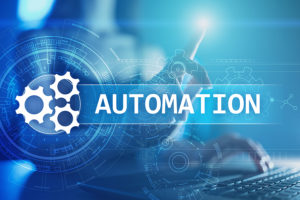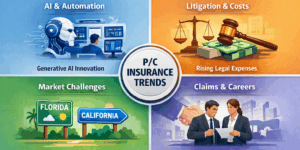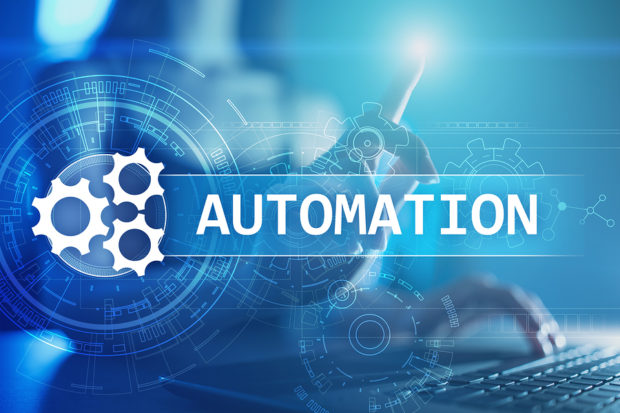Shortly after World War II, as the Ford Motor Company returned to making cars, one of its more innovative executives, Del Harder, mechanized entire segments of the production line with built-in, electronic controls to ensure that work was meeting the appropriate standards. Harder’s Automation Department reportedly expanded from five to 50 people within a year as the company retrofitted some of its factories to accommodate the technology.
Executive Summary
From business rules engines to artificial intelligence, both existing and new technologies yield opportunities for better, more strategic decision-making throughout the claims process, according to Alex Sun, CEO of Mitchell International.Here, he describes three ways claims organizations can reap the benefits of both legacy and intelligent automation while ensuring that people remain at the forefront: increased straight-through processing, AI in support of complex decision-making and risk scoring.“What we need is more automation,” Harder is famously thought to have said.
Harder’s call for increasing automation is as relevant today as it was for Ford more than 70 years ago.
The challenge for claims management is more than just increasing automation. It is finding those applications that offer significant added value through improved operational efficiencies, increased accuracy and lower costs.
Perhaps the best opportunity is how these improvements will leverage the vast pools of data to enable claims management to make better, more-informed decisions. It’s that human decision-making, enabled by accelerating technological advances, that can result in better outcomes, both for the policyholder and for the insurance carrier.
Claims Organizations and the Quest for Increased Automation
Automating claims workflows using well-established technology like business rules engines has long been an industry go-to and will undoubtedly remain a valuable mainstay, even as companies increasingly turn to advanced technologies for additional support. According toa 2019 Accenture study on digital transformation in insurance, 60 percent of insurerrespondents seek to use artificial intelligence (AI)-based technologies to improve operationalprocesses.
 But improved operational efficiency may only scratch the surface of the potential benefits. Automation of all types—both rules-based and intelligent—can have significant impact well beyond operational efficiencies. It can also free workers from rote tasks, providing them with more time to focus on human-centered work and complex decision-making. With an increased focus on the most complex claims, there are increasing opportunities to improve outcomes.
But improved operational efficiency may only scratch the surface of the potential benefits. Automation of all types—both rules-based and intelligent—can have significant impact well beyond operational efficiencies. It can also free workers from rote tasks, providing them with more time to focus on human-centered work and complex decision-making. With an increased focus on the most complex claims, there are increasing opportunities to improve outcomes.
This is the notion of “humane automation“: that as claims organizations maintain and ramp up their investments in automation technologies, the focus on the benefits to people—both employees and customers—takes on ever greater importance.
Whether implementing well-established technology like business rules, emerging AI-enabled technology or applications of technology like predictive analytics, here are three ways claims organizations can reap the benefits of both legacy and intelligent automation while ensuring that people remain at the forefront.
Increasing Straight-Through Processing
With casualty claims processing that involves evaluation and payment of large quantities of medical bills, business rules engines can identify low-complexity, low-dollar, medical-only bills and process them with limited human intervention. These opportunities are usually more than just a simple sort, with rules layered upon rules depending upon the nature of the injury and the complexity of possible treatment.
Mitchell estimates that upward of 80 percent of claims organizations still require a human touch on every medical bill. By leveraging rules engines to support straight-through processing, those claims organizations could reduce the number of medical bills that a human has to be involved withto as low as 20 percent. As a result, those medical bills could be processed more consistently and with greater accuracy, reducing turnaround time and lowering the cost of processing those claims.
Increasing straight-through processing has another advantage: It enables adjusters to quickly identify and focus on the most complex claims where human intervention is likely to have the greatest impact.
Supporting Complex Decision-Making
At its core, the notion of decision support is about providing the right information to the right people at the right point in the claims process. Decision support, a decades-old concept, can be significantly enhanced with the use of AI. Here are two examples that demonstrate the range of possibilities:
Automated adjusting. The “holy grail” of claims management may well be end-to-end virtual, automated claims adjusting. It may not happen in the near term, but clearly there are emerging opportunities to use automation to improve insurance adjuster decision-making. For example, processing of vehicle damage claims is one area where my firm is using AI and related technology to help insurers make better vehicle repair decisions.
The process works by using millions of damaged vehicle photos. Algorithms are trained to recognize vehicle damage and use computer vision, an AI tool, to double-check repair vs. replace decisions. This will help carriers achieve better estimate consistency, maintain estimate quality and be more selective about sending appraisers into the field, all while improving cycle times and productivity.
Medical claims processing interventions. When is the best time to intervene in the claims management process and, for example, order additional services? When should issues like quality of care initiate an intervention from a cost-benefit perspective?The addedservices could include independent medical reviews, nurse case management and field case management services.
AI analysis on data on outcomes can guide these decisions. This kind of decision-making at the right time in the claims process can make the difference between full recovery and returning the injured employee back to work. The alternative, without this intervention, can turn into a costly permanent disability or a much larger settlement. The human cost is even greater.
Identifying the Potential for New and Emerging Risks
The ability to compile immense amounts of data into actionable insights is crucial to the managementof risk. Predictive analytics is a practice that analyzes historical data to predict future outcomes with a given level of certainly. It doesn’t predict what will or will not happen but rather what may happen and with what likelihood. This process results in what is commonly referred to as a risk score: the likelihood of a particular outcome.
Predictive analytics can be applied broadly across the claims continuum, resulting in risk scores for everything from the likelihood that a third-party auto casualty claim might result in litigation to whether or not an injured worker might be at risk of opioid addiction. In the latter example, instead of waiting until a claimant is already at a point of high risk, predictive analytics can help facilitate early and proactive intervention to keep recovery on track. This has the potential to improve many aspects of the claims process, but most importantly patient outcomes.
The Case for Humans in Claims Automation
When Tesla was failing to meet Model 3 production goals, Elon Musk attributed the delay to overly complex, automated processes. Ultimately, he replaced some of those automated systems with old-school—that is to say human—technology, enabling the company to ramp up production. In direct contrast to Del Harder’s call for more automation, Musk summed up the experience in a tweet saying, “Excessive automation at Tesla was a mistake. To be precise, my mistake. Humans are underrated.”
These contrasting points of views serve to underscore the thinking at the heart of “humane automation.”Central to a people-first approach to claims automation is, of course, people—both claims organizations and claimants. Casualty claims are generally complex, the opportunities for automation broad and the toolbox of technologies to implement expanding faster than ever.
The technology’s benefits may be only the start of what’s to come. AI will make the identification of claims needing review easier to see. In turn, the more claims organizations use the technology, the smarter it will become, leading to improvements in efficiency, accuracy and consistency. The insights these smarter systems generate will lead to improved service and better outcomes, helping us help our clients restore their customers’ lives.
A version of this article was published on the Mitchell International website on Sept. 9. 2019.





















 Underwriter, Actuary Fears of AI Drop; Work Needed on Collaboration
Underwriter, Actuary Fears of AI Drop; Work Needed on Collaboration  Carrier Management’s 2025 Top Features (Reader’s Picks Unlocked)
Carrier Management’s 2025 Top Features (Reader’s Picks Unlocked)  Adapting Insurance Talent Models for a More Volatile, Tech-Driven Market
Adapting Insurance Talent Models for a More Volatile, Tech-Driven Market  How Insurers Can Avoid Post-Merger Technology Failure
How Insurers Can Avoid Post-Merger Technology Failure 


